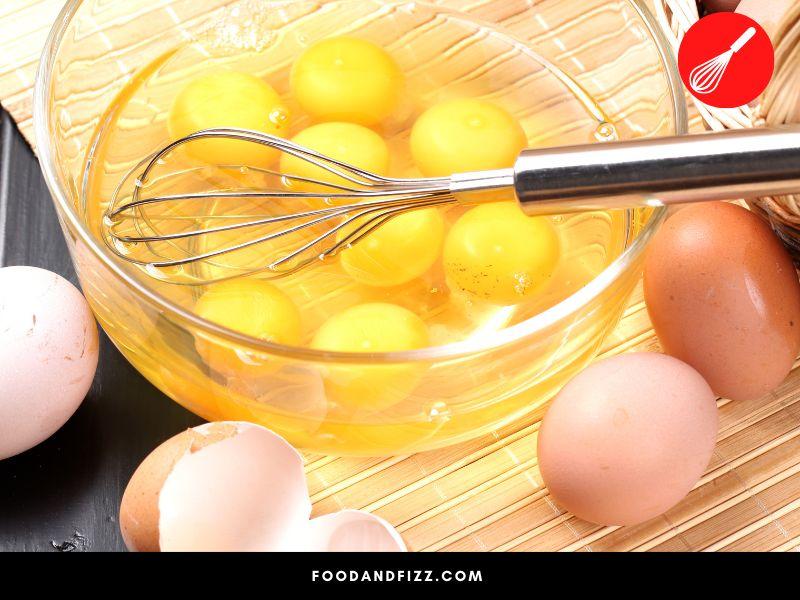Scrambled eggs are packed with protein and other essential nutrients, like iron and B12. Whether they’re eaten alone, with veggies, or on toast, they’re a great way to start off your day.
Unfortunately, scrambled eggs don’t always look appetizing. If the eggs you cook at home have an unappealing gray color, you may be tempted to toss them in the trash.
Why Do Scrambled Eggs Turn Grey?
Scrambled eggs turn grey because of the formation of ferrous sulfide. When eggs are cooked for too long, they begin to release sulfur and iron. This can start a chemical reaction that causes scrambled eggs to go from yellow to greenish-grey. The best way to prevent this from happening is to cook eggs slowly at a low temperature.

The discoloration isn’t just something you have to worry about with scrambled eggs. No matter how you cook your eggs, they can turn gray if you cook them at high heat or for too long.
It’s common for eggs to take on a gray tint, but eggs may also turn green or even blue. While the color of the eggs may vary, this process is caused by the same chemical reaction.
Is It Safe to Eat Gray Eggs?
Gray eggs might look gross, but they’re still perfectly safe to eat. The chemical process that makes eggs change color isn’t dangerous in any way.
With that said, there are plenty of reasons to avoid gray eggs. Eggs that have been cooked for too long may have an unpleasant flavor or odor.
While you don’t have to let gray eggs go to waste, you can make sure that your eggs don’t turn gray in the first place. With the right cooking techniques, you can make sure that your eggs look as good as they taste.
How to Keep Eggs From Turning Gray
If you wind up with a gray mess every time you try to cook scrambled eggs, you need to change the way you’re preparing your eggs. With these simple tips, you’ll be able to avoid the issues that cause eggs to go gray.
1. Make Sure You’re Using Fresh Eggs
Even if they’re not expired, older eggs are more likely to release sulfur as they cook. The fresher your eggs are, the better they’ll be.

2. Use the Right Cookware
When you use high-quality cookware, heat will be evenly distributed across the pan. You’ll find that cooking eggs are much easier when you have the tools you need for the job.
3. Cook Eggs Over Low Heat
Overheating is the main reason eggs go gray, which is why you should always cook eggs over low heat. While it may take longer to prepare your eggs, you’ll get much better results

4. Don’t Let Your Pan Warm Up
The next time you prepare scrambled eggs, try adding them to the pan while it’s still cold. This will make it easier for you to control the temperature of your pan.
5. Watch Your Eggs Closely
Slowly cooking your eggs can keep them from overheating, but if you’re not careful, you could forget about your eggs entirely. Keep a close eye on your eggs so that you can remove them from the pan at the perfect time.
How to Cook Perfect Scrambled Eggs
Even if your eggs aren’t gray, you may not be satisfied with the quality of your scrambled eggs. With these techniques, you’ll be able to make golden, fluffy scrambled eggs in the comfort of your own kitchen.
1. Whisk Your Eggs Before You Add Them to the Pan
You should never crack your eggs straight into the pan. Instead, you should crack your eggs in a bowl, whisk them, and then pour them into your pan.

2. Avoid Milk and Cream
It’s common to add milk and cream to scrambled eggs, but this can actually leave you with runny eggs that don’t scramble well. If you want to make your eggs creamier, try adding butter or olive oil instead.
3. Use the Right Kind of Spatula
With the right tools, it will be easier to create curds and give your eggs the perfect scramble. For scrambled eggs, rubber and silicone spatulas are your best bet.
4. Bring Your Eggs to Room Temperature
Take your eggs out of the fridge ahead of time and let them heat up to room temperature. Eggs mix better when they’re at room temperature, which can give you a better scramble.
5. Let Your Eggs Rest
While it’s tempting to constantly stir your eggs as they cook, you’ll get better results if you let them sit for a bit before you pull out your spatula. Once the edges of the eggs start to set, you can start scrambling your eggs.
6. Remove Your Eggs From the Pan Before They’re Fully Cooked
Eggs are a protein, which means they’ll continue to cook even after they’re removed from the pan. It’s best to transfer your eggs to a plate while they’re slightly runny.
How can you tell when your eggs are done? You can turn off your stove when your eggs are solid, but still have some moisture to them.

How Can I Tell If My Eggs Are Spoiled?
While gray eggs might look like they’ve gone bad, they’re usually not spoiled. Still, since eggs can be a breeding ground for salmonella, it’s best to show caution if you think your eggs might be expired.
Eggs can last for weeks beyond their expiration date, but if your eggs have an unusual odor, they’re not safe to eat. A smell test is the easiest way to tell if an egg is good or bad.
Before you crack an egg, check to make sure there are no cracks in its shell. If an egg does have a crack, it may be a carrier for bacteria and should be thrown away.
You can also check the freshness of your eggs with a simple float test. While this won’t tell you if an egg has expired, it’s an easy way to identify old eggs in your fridge.
To do a float test, just place the egg in a bowl of water. Eggs that float are fresh, and eggs that sink are old.
Conclusion to Why Do Scrambled Eggs Turn Grey
No matter what color they are, scrambled eggs are a delicious and nutritious dish. With these tips, you’ll be able to cook fluffy scrambled eggs that have an appetizing golden color.
Frequently Asked Questions About Why Do Scrambled Eggs Turn Grey
Can I Cook Scrambled Eggs In the Microwave?
It’s fine to heat eggs in the microwave as long as they’re cooked through. Just be aware that microwaving your eggs could leave them overheated.
Do Eggs Need to Be Refrigerated?
In the United States, eggs are washed before they’re sent to stores, which removes the protective cuticle on the eggshell. Because of this, eggs should be refrigerated to reduce the risk of food poisoning.
How Long Do Cooked Eggs Keep In the Fridge?
Cooked eggs can last for three to four days in the fridge. Make sure you seal your leftover eggs in an airtight storage container.

